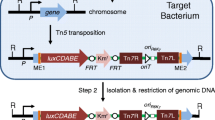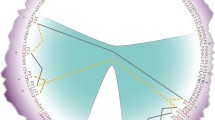Abstract
There has recently been increasing interest in the development of radioprobes that specifically target proteins transcribed from expression of reporter genes of interest. The purpose of this study was to develop a radioprobe that targets one of the most widely used reporter genes, the bacterial lacZ gene. We synthesised and purified radioiodine-labelled phenylethyl-β-d-thiogalactopyranoside (PETG), a competitive inhibitor specific against Escherichia coli β-galactosidase. We showed that [125I]iodo-PETG specifically binds to β-galactosidase as verified by column chromatography and polyacrylamide gel electrophoresis after incubation of radiotracer with the protein. We also showed through enzyme kinetic studies that iodo-PETG retains inhibitory action against β-galactosidase activity. COS-7 cells infected with a recombinant adenovirus expressing the lacZ gene had viral titre-dependent enhancements in [125I]iodo-PETG uptake (r 2=0.897; P=0.001), which reached up to 642.5%±16.7% of control levels (P<0.00001). Moreover, the level of uptake was highly correlated to luminescent measurements of β-galactosidase activity (r 2=0.878; P<0.0001). These results confirm that radioiodine-labelled PETG specifically targets β-galactosidase and that its uptake rates faithfully reflect levels of expression of the lacZ reporter gene. Further investigations were performed in nude mice bearing human neuroblastoma tumours transferred with the lacZ gene. Compared with control tumours, lacZ-expressing tumours were slightly better visualised on [123I]iodo-PETG images and had a modest increase in tumour to muscle count ratio (2.6±0.2 vs 1.9±0.1, P<0.05). The present results provide proof-of-principle for the potential of radiolabelled inhibitors as promising radiotracers to monitor lacZ gene expression levels. Future modifications to improve cell permeability should enhance in vivo contrast levels and may allow the use of radiolabelled β-galactosidase inhibitors for non-invasive monitoring of lacZ gene expression.






Similar content being viewed by others
References
Alam J, Cook JL. Reporter genes: application to the study of mammalian gene transcription. Anal Biochem 1990; 188:245–254.
Huard J, Akkaraju G, Watkins SC, Pike-Cavalcoli M, Glorioso JC. LacZ gene transfer to skeletal muscle using a replication-defective herpes simplex virus type 1 mutant vector. Hum Gene Ther 1997; 8:439–452.
Ray P, Bauer E, Iyer M, Barrio JR, Satyamurthy N, Phelps ME, Herschman HR, Gambhir SS. Monitoring gene therapy with reporter gene imaging. Semin Nucl Med 2001; 31:312–320.
Jacobs A, Tjuvajev JG, Dubrovin M, Akhurst T, Balatoni J, Beattie B, Joshi R, Finn R, Larson SM, Herrlinger U, Pechan PA, Chiocca EA, Breakefield XO, Blasberg RG. Positron emission tomography-based imaging of transgene expression mediated by replication-conditional, oncolytic herpes simplex virus type 1 mutant vectors in vivo. Cancer Res 2001; 61:2983–2995.
Gambhir SS, Barrio JR, Phelps ME, Iyer M, Namavari M, Satyamurthy N, Wu L, Green LA, Bauer E, MacLaren DC, Nguyen K, Berk AJ, Cherry SR, Herschman HR. Imaging adenoviral-directed reporter gene expression in living animals with positron emission tomography. Proc Natl Acad Sci U S A 1999; 96:2333–2338.
Liang Q, Satyamurthy N, Barrio JR, Toyokuni T, Phelps MP, Gambhir SS, Herschman HR. Noninvasive, quantitative imaging in living animals of a mutant dopamine D2 receptor reporter gene in which ligand binding is uncoupled from signal transduction. Gene Ther 2001; 8:1490–1498.
Kundra V, Mannting F, Jones AG, Kassis AI. Noninvasive monitoring of somatostatin receptor type 2 chimeric gene transfer. J Nucl Med 2002; 43:406–412.
Choi JH, Choe YS, Lee KH, Choi Y, Kim SE, Kim BT. Synthesis of radioiodine-labeled 2-phenylethyl 1-thio-beta-d-galactopyranoside for imaging of LacZ gene expression. Carbohydr Res 2003; 338:29–34.
Lee SY, Choe YS, Kim DH, Park BN, Kim SE, Choi Y, Lee KH, Lee J, Kim BT. A simple and efficient in vitro method for metabolism studies of radiotracers. Nucl Med Biol 2001; 28:391–395.
Fukumoto S, Hsieh CM, Maemura K, Layne MD, Yet SF, Lee KH, Matsui T, Rosenzweig A, Taylor WG, Rubin JS, Perrella MA, Lee ME. Akt participation in the Wnt signaling pathway through Dishevelled. J Biol Chem 2001; 276:17479–17483.
Fiering SN, Roederer M, Nolan GP, Micklem DR, Parks DR, Herzenberg LA. Improved FACS-galactosidase: flow cytometric analysis and sorting of viable eukaryotic cells expressing reporter gene constructs. Cytometry 1991; 12:291–301.
Hadd AG, Raymond DE, Halliwell JW, Jacobson SC, Ramsey JM. Microchip device for performing enzyme assays. Anal Chem 1997; 69:3407–3412.
Jongkind JF, Verkerk A, Sernitz M. Detection of acid-β-galactosidase activity in viable human fiboblasts by flow cytometry. Cytometry 1986; 7:463–466.
Weiss DJ, Liggitt D, Clark JG. Histochemical discrimination of endogenous mammalian beta-galactosidase activity from that resulting from lac-Z gene expression. Histochem J 1999; 31:231–236.
Plagemann PG, Wohlhueter RM, Graff J, Erbe J, Wilkie P. Broad specificity hexose transport system with differential mobility of loaded and empty carrier, but directional symmetry, is common property of mammalian cell lines. J Biol Chem 1981; 256:2835–2842.
Ishiwata K, Yamaguchi K, Kameyama M, Fukuda H, Tada M, Matsuzawa T, Muraishi K, Itoh J, Kawashima K, Takahashi T. 2-Deoxy-2-[18F]fluoro-d-galactose as an in vivo tracer for imaging galactose metabolism in tumors with positron emission tomography. Int J Rad Appl Instrum B 1989; 16:247–254.
Acknowledgements
The authors thank Hye-Kyoung Kim for technical assistance. This work was supported in part by the National Mid- and Long-term Nuclear R&D Program Grant # M20333010001-03A0726-00114 of the Korean Ministry of Science and Technology.
Author information
Authors and Affiliations
Corresponding author
Additional information
This work was presented in part at the 49th Annual Meeting of the Society of Nuclear Medicine, LA, USA, June 15–19, 2002.
Rights and permissions
About this article
Cite this article
Lee, KH., Byun, S.S., Choi, J.H. et al. Targeting of lacZ reporter gene expression with radioiodine-labelled phenylethyl-β-d-thiogalactopyranoside. Eur J Nucl Med Mol Imaging 31, 433–438 (2004). https://doi.org/10.1007/s00259-003-1395-7
Published:
Issue Date:
DOI: https://doi.org/10.1007/s00259-003-1395-7




